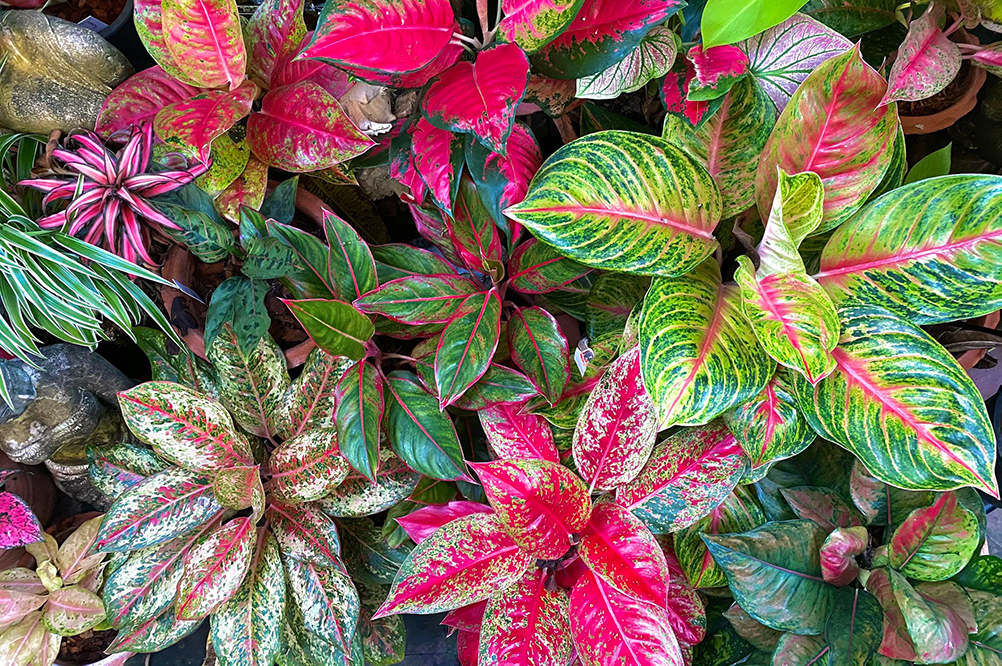Growing Aglaonema

Aglaonemas are often vibrant and colorful, with strikingly patterned leaves. Because they’re so easy-going, Aglaonemas are perfectly suited for a modern living room or office, bedroom, or cozy study. Because of their tolerance for both moist and dry conditions, and the fact that they will thrive with low light, they are a perfect choice for less than ideal light conditions or forgetful plant owners.
The following care instructions will be helpful in the process of plant cultivation:
- Proper care for aglaonema starts with its proper placement. Your task is to find the area that receives less indirect light.
- Place your plant far from doors, air vents and windows in order to ensure it won’t suffer from drafts.
- Fertilize the species at least 2 times per month. Water them from spring until autumn with an appropriate solution (1 tsp. soluble 20-20-20 analysis fertilizer and 1 gallon of water).
- Water the plant when the top 2 inches of the soil start getting dry.
- One of the basic care instructions includes wiping the leaves with a moistened cloth to remove dust and dirt.
Toxicity: Besides all the aglaonema care tips, it is essential to keep in mind that the plant is toxic to cats and can be dangerous for people. To ensure safety, wear gloves when handling aglaonema. If your pets show signs of poisoning, weakness, disorientation or diarrhea, contact your veterinarian immediately.
Planting
How to plant aglaonema
- chop the stem’s top that has gotten leggy and root the stem in the soil or water
- as too much soil can encourage rot, take a 2:1 mix of perlite to potting mix, though straight perlite is rather difficult to work with
- transfer the root to a regular pot.
When to transplant aglaonema
Transplanting should take place once every 2-3 years, because these plants grow very slowly. When there is the need to remove aglaonema into a larger pot, the season doesn’t matter.
Care
How to prune aglaonema
Watch for new growth coming up at the base of the plant. Remove it from the base and replant in a separate pot. Don’t start pruning the plant beyond dying or removed dead leaves. In this case growth will emerge from the crown and you won’t manage to prune it without killing your favorite plant. See step by step how to prune houseplants.
Watering:
In nature, aglaonema receives daily abundant watering, and it grows in soil that is well permeable to moisture and air. When kept indoors, during the growing season aglaonema should be watered abundantly. In autumn and winter reduce watering, but remember that overdrying of the soil is dangerous for aglaonema. You should also avoid pouring aglaonema during the cool period.
The water for watering should be soft, well-settled and its temperature should not be lower than room temperature.
Lighting:
Some varieties of the plant can easily grow in near shade. Variegated varieties of aglaonema require brighter light, but that doesn’t mean they are to be exposed to direct sun. You will notice if the plant lacks the light, as its leaf stems will become long and leggy. At the same time, aglaonema cannot tolerate direct sunlight, which causes leaf burns.
Temperature:
In winter, the temperature for aglaonema should not drop below +16 °C (60 °F). The perfect temperature for growth is +20 °C +25 °C (68 – 77 °F). The warmer it is, the better aglaonema plants grow. Drafts, sharp temperature changes are unacceptable for aglaonema.
Air humidity:
Aglaonema prefers high humidity. In summer, it is better to spray it daily. It is also necessary to regularly clean the leaves from dust. Do not cover the leaves with shine solution. To ensure proper humidity you can place pots with plants on trays of wet expanded clay.
Fertilizer:
During the period of active growth, aglaonema should be fed with liquid mineral fertilizer 2 times a month. Do not feed the plant in winter.
Pests/Diseases
The most common aglaonema pests are root mealybugs, aphids, scales and mites. As a rule the plant can suffer from them during propagation stages. When they are left untreated, the plant will die.
The most serious aglaonema diseases include:
-
- Fusarium stem rot: this is a soft mushy rot at the base of the rotted plant or a cutting. The possible way out is to remove the plants that have been infected.
- Pythium: this disease is referred to as one of the commonest root problems, and occurs under wet conditions or in poorly drained soils.
- Myrothecium and Colletotrichum: these are diseases that lead to leaf spots during propagation.
Website: www.tipsplant.com